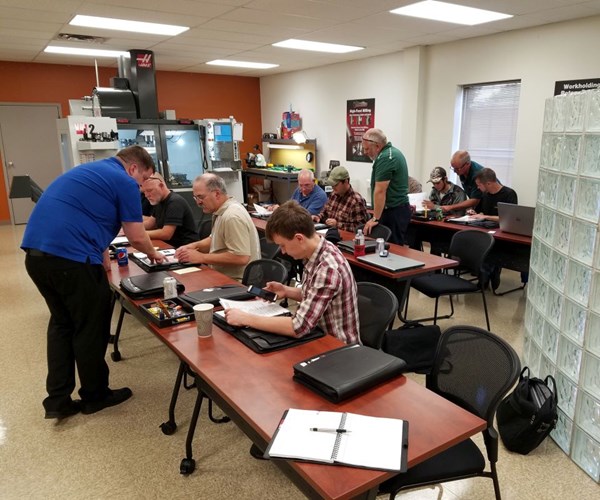Tool Mfr. Commits to Marketing-Free Product Training Seminars
Responding to feedback from its customers, Dapra Corp. changed its seminar model to focus less on marketing, and more on technical training.

Attendees calculate speed and feed with the assistance of Dapra’s applications specialists during a training seminar at the company’s Midwest Technical Center in Rockford, Illinois. (Photo courtesy of Dapra Corp.)
For several years Dapra Corp. has had a technical center in Rockford, Illinois, where, like many other OEMs, the cutting tool manufacturer has conducted training sessions there for its end users and distributors. Recently, however, the company decided to make a change to its training model in response to customer comments about the difficulty of finding and training skilled labor.
Until recently, according to Product Manager Mike Bitner, the two-day seminars had been similar to other vendor-sponsored classes, with ample marketing material included in the training. In fact, it’s been a common complaint from Dapra’s customers that supplier training sessions put more time into product features and benefits than on practical machining training.
“Dapra decided to change that format and dedicate 100 percent of the time to technical milling training,” says Mr. Bitner, who adds that the training provided in these redesigned seminars can be applied to the use of any solid or indexable milling tool from any manufacturer. According to an article Mr. Bitner wrote recently, the topics covered in these seminars now include: choosing speeds and feeds from supplier literature; using speed and feed formulas; climb versus conventional milling; long-reach milling considerations; selection of toolholder style; air versus coolant tooling; coarse-pitch versus fine-pitch tooling; insert grades and geometries; soft versus hard milling techniques; chip thinning (axial and radial); chip formation and tool pressure based on cutting geometry; toolpath selections; and troubleshooting, including wear and failure characteristics.
“The program is really intended for anyone involved in the milling process from programming through setup,” says Mr. Bitner. “Very few of our competitors have field personnel capable of providing on-site training that teaches an end user how to get the most from new cutting tool technology. It is much more common that a manufacturer’s sales engineer is adept enough to conduct a test that earns him the sale, but is not savvy enough to spend the time educating the customer fully on the product. This results in much trial and error on the customer’s part finding out what they can and can’t do with the cutting tool, which can obviously get expensive and frustrating.”
In a program intended to benefit milling machine operators of varying skill levels, the intensive two-day seminar has been reduced to a maximum of 14 attendees at a time, allowing for one-on-one support. “We do not simply lecture for two days on milling techniques and formulas,” Mr. Bitner says. “We engage the class with practical demos on the machine tool, creating teams that are tasked with choosing a grade and geometry for an application, then calculating the proper speeds and feeds for each one as well. We discuss each team's findings as a group before we demonstrate the application, allowing everyone to participate and make safe mistakes.” He adds that the company has received positive feedback from this hands-on approach. Attendees say that the modules on tool selection and calculation of speeds and feeds have been the most beneficial.
Related Content
All-Around Mill Improves Productivity and Cost for Valve Job
Adopting a mill with a double-negative rake and pockets compatible with multiple insert geometries enabled Progressive Metal Service to increase feed and lower scrap rates for a valve.
Read More6 Tips for Training on a Swiss-Type Lathe
There are nuances to training a person to effectively operate a Swiss-type lathe. Derek Korn, Production Machining’s editor in chief, shares suggestions from a CNC machine shop.
Read MoreIf the Federal Government Is to Solve the Manufacturing Labor Shortage, it Needs to Start Here
Student-run businesses focused on technical training for the trades are taking root across the U.S. Can we — should we — leverage their regional successes into a nationwide platform?
Read MoreCan Connecting ERP to Machine Tool Monitoring Address the Workforce Challenge?
It can if RFID tags are added. Here is how this startup sees a local Internet of Things aiding CNC machine shops.
Read MoreRead Next
The Cut Scene: The Finer Details of Large-Format Machining
Small details and features can have an outsized impact on large parts, such as Barbco’s collapsible utility drill head.
Read More3 Mistakes That Cause CNC Programs to Fail
Despite enhancements to manufacturing technology, there are still issues today that can cause programs to fail. These failures can cause lost time, scrapped parts, damaged machines and even injured operators.
Read More











.png;maxWidth=300;quality=90)














